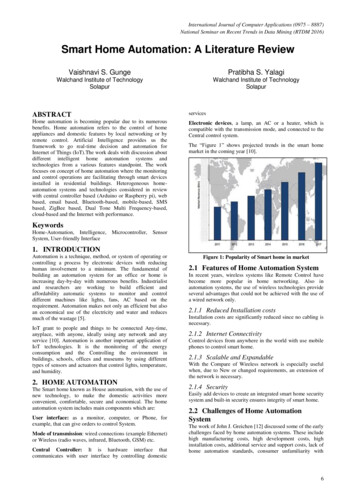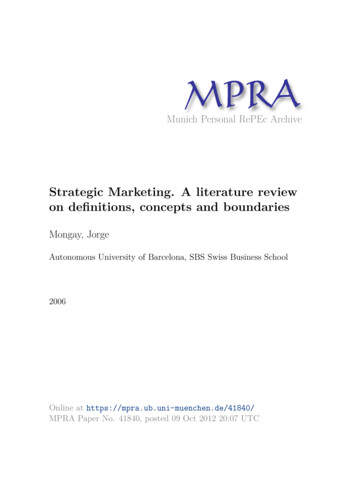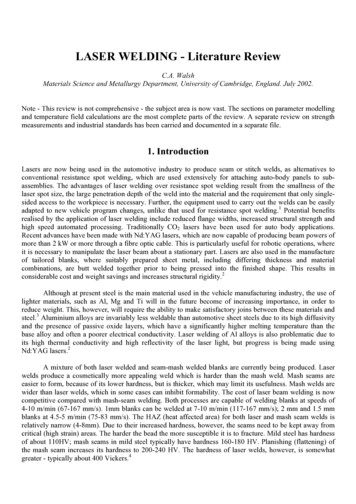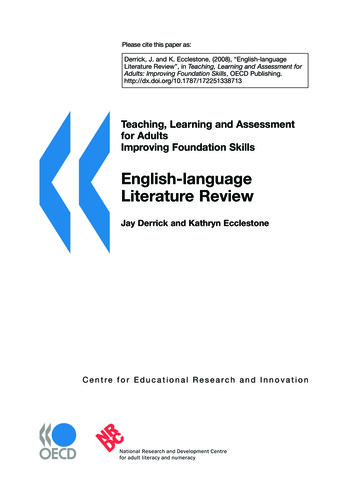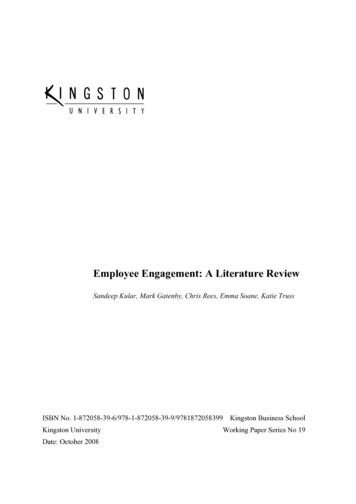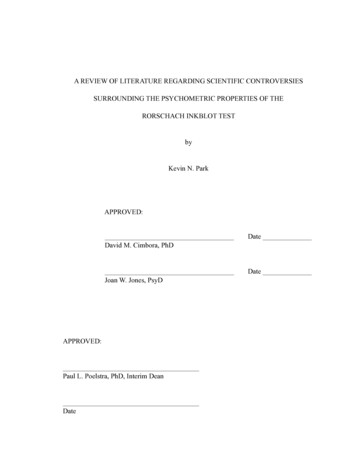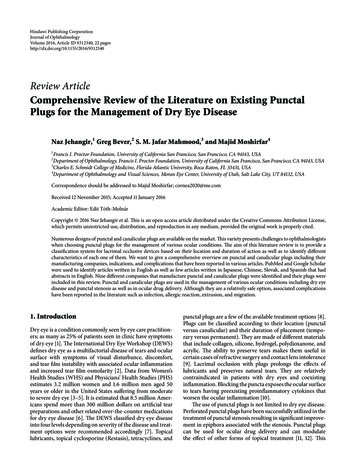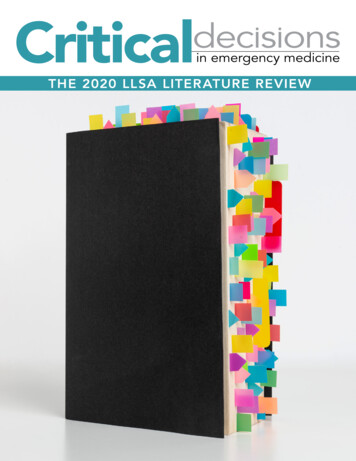
Transcription
THE 2020 LLSA LITER ATURE REVIEW
The LLSA Literature ReviewSynopses of articles from ABEM’s 2020 LifelongLearning and Self-Assessment Reading ListFROM THE EDITORSSince April 2003, Critical Decisions in Emergency Medicine has included the bonus feature“The LLSA Literature Review.” The impetus for this section was our desire to provide ACEPmembers with yet another tool to use when preparing for the continuous certificationinitiative of the American Board of Emergency Medicine (ABEM), specifically the LifelongLearning and Self-Assessment (LLSA) tests. Each year, as part of this program, ABEMpublishes a list of articles focused on selected portions of the emergency medicine corecontent. These articles become the LLSA reading list for that year, and the questions for thetests are drawn from these articles.Since November 2019, each monthly issue of Critical Decisions has provided a summaryof one of the articles from ABEM’s 2020 reading list, with bullets highlighting theelements relevant to emergency medicine practice. This online supplemental issueincludes a full collection of those summaries, which are intended to highlight theimportant concepts of each article. We are pleased to offer this benefit FREE to ACEPmembers, and hope you find it useful. ACEP members also can download full versions ofthe articles by logging in at acep.org/llsa.If you would like to see what else Critical Decisions has to offer (clinical lessons,ECG and imaging reviews, drug reviews, and more), we invite you to explore a sampleissue online at www.acep.org/cdem.Best wishes,Andrew J. Eyre, MD, Section EditorHarvard Affiliated Emergency Medicine ResidencyBrigham and Women’s HospitalMichael S. Beeson, MD, MBA, FACEPNortheastern Ohio Universities2020 LLSA Literature ReviewnSpecial Edition2
IN THIS ISSUEIdarucizumab for Dabigatran Reversal . . . . . . . . . . . . . . . . . . . . . . . 4Opioid-Prescribing Policies . . . . . . . . . . . . . . . . . . . . . . . . . . . . . . . . . 5Acute Myocardial Infarction . . . . . . . . . . . . . . . . . . . . . . . . . . . . . . . . 6Acute Diarrheal Infections . . . . . . . . . . . . . . . . . . . . . . . . . . . . . . . . . 7Child Abuse . . . . . . . . . . . . . . . . . . . . . . . . . . . . . . . . . . . . . . . . . . . . . 8Acute Spinal Cord Compression . . . . . . . . . . . . . . . . . . . . . . . . . . . . 9Nonpenetrating Eye Injuries in Children . . . . . . . . . . . . . . . . . . . . . 11Acute Lower Gastrointestinal Bleeding . . . . . . . . . . . . . . . . . . . . . . 12Pediatric Airway and Rapid Sequence Intubation . . . . . . . . . . . . . 13Necrotizing Soft-Tissue Infections . . . . . . . . . . . . . . . . . . . . . . . . . . 14Transient Ischemic Attack . . . . . . . . . . . . . . . . . . . . . . . . . . . . . . . . . 16MRI Safety in Patients With Cardiac Devices . . . . . . . . . . . . . . . . . 17Intramuscular Sedation for Agitation . . . . . . . . . . . . . . . . . . . . . . . . 18Pediatric Shock . . . . . . . . . . . . . . . . . . . . . . . . . . . . . . . . . . . . . . . . . 19Critical Decisions in Emergency Medicine is the officialCME publication of the American College of EmergencyPhysicians. Additional volumes are available.EDITOR-IN-CHIEFMichael S. Beeson, MD, MBA, FACEPNortheastern Ohio Universities,Rootstown, OHSECTION EDITORSJoshua S. Broder, MD, FACEPDuke University, Durham, NCAndrew J. Eyre, MD, MHPEdBrigham & Women’s Hospital/Harvard Medical School, Boston, MAJohn Kiel, DO, MPHUniversity of Florida College of Medicine,Jacksonville, FLFrank LoVecchio, DO, MPH, FACEPMaricopa Medical Center/Banner Phoenix Poisonand Drug Information Center, Phoenix, AZAmal Mattu, MD, FACEPUniversity of Maryland, Baltimore, MDLynn P. Roppolo, MD, FACEPUT Southwestern Medical Center,Dallas, TXChristian A. Tomaszewski, MD, MS, MBA, FACEPUniversity of California Health Sciences,San Diego, CASteven J. Warrington, MD, MEdOrange Park Medical Center, Orange Park, FLASSOCIATE EDITORSWan-Tsu W. Chang, MDUniversity of Maryland, Baltimore, MDWalter L. Green, MD, FACEPUT Southwestern Medical Center,Dallas, TXJohn C. Greenwood, MDUniversity of Pennsylvania, Philadelphia, PADanya Khoujah, MBBSUniversity of Maryland, Baltimore, MDSharon E. Mace, MD, FACEPCleveland Clinic Lerner College of Medicine/Case Western Reserve University, Cleveland, OHNathaniel Mann, MDGreenville Health System, Greenville, SCGeorge Sternbach, MD, FACEPStanford University Medical Center, Stanford, CAJoseph F. Waeckerle, MD, FACEPUniversity of Missouri-Kansas City School of Medicine,Kansas City, MOEDITORIAL STAFFRachel Donihoo, Managing Editorrdonihoo@acep.orgISSN2325-0186 (Print)ISSN2325-8365 (Online)
Idarucizumab forDabigatran ReversalBy Rachel Gartland, MD; and Michael E. Abboud, MDDepartment of Emergency Medicine,University of Pennsylvania, PhiladelphiaReviewed by Andrew Eyre, MD, MHPEdGottlieb M, Khishfe B. Idarucizumab for the reversal of dabigatran.Ann Emerg Med. 2017 May;69(5):554-558.The emergent reversal of anticoagulation is becoming increasingly complex as more pharmaceuticaloptions become available. Dabigatran (ie, Pradaxa), a relatively newer anticoagulant, is a direct thrombininhibitor. When dabigatran was released in 2010, however, there was no known reversal agent for themedication. As such, proposed treatments for life-threatening bleeding in patients taking the drugincluded the administration of fresh frozen plasma and factor VII, hemodialysis, and supportive care.In 2015, the FDA approved idarucizumab (ie, Praxbind), a monoclonal antibody specific to thethrombin-binding site on dabigatran, for the reversal of dabigatran-associated anticoagulation.Idarucizumab binds to dabigatranwith 350 times greater affinity than itdoes to thrombin, making it an excellentreversal agent. Studies show that theelevations in multiple coagulationparameters (eg, activated partialthromboplastin time and activatedclotting time) seen with dabigatrantherapy completely normalize with theadministration of idarucizumab.Importantly, these values do notovercorrect, which helps avoid thehypercoagulable states often associatedwith other medications and productsused for anticoagulation reversal. Inaddition, the adverse effects reportedin patients using idarucizumab (ie,headaches and skin and infusion siteirritation) are mild and well tolerated.Idarucizumab also works rapidlyand wears off quickly, with a half-lifeof less than 1 hour in healthy patients.Both dabigatran and idarucizumabare renally excreted; so, while thereversal of dabigatran is just as fast andeffective in patients with renal disease,clearance of these medications maybe decreased. Nevertheless, restartingdabigatran therapy 24 hours afterthe administration of idarucizumableads to the reinitiation of effectiveanticoagulation in those without renaldisease, regardless of age. Subsequentdoses of idarucizumab or otherhemostatic agents may be requiredfor patients who require prolongedanticoagulation reversal.While idarucizumab is a promisingalbeit expensive antidote for patientswho require dabigatran reversal,clinically relevant outcomes, such asclinical hemostasis and overall mortality(compared to placebo), have not beenclearly described. Although the trueutility of the drug has yet to be fullyelucidated, its timely use in specificpatient populations is advised.KEY POINTSn Dabigatran is a direct thrombin inhibitor. Idarucizumab, a monoclonalantibody specific to dabigatran’s thrombin-binding site, was developed asa dabigatran reversal agent.n Idarucizumab has a short half-life and a high affinity for dabigatran, leadingto the fast, complete correction of dabigatran-induced anticoagulation.This short half-life also enables the early reinitiation of dabigatran.n Idarucizumab is generally well tolerated and has few adverse effects. Inparticular, it does not cause hypercoagulability, a complication often seenwith other reversal techniques.n It is not yet known if the fast and complete normalization of coagulationand laboratory parameters leads to more clinically relevant outcomes.2020 LLSA Literature ReviewnSpecial Edition4
Opioid-PrescribingPoliciesBy Andrew Mittelman, MD; and Laura Welsh, MDDepartment of Emergency Medicine,Boston University, MassachusettsReviewed by Andrew Eyre, MD, MHPEdOsborn SR, Yu J, Williams B, Vasilyadis M, Blackmore CC.Changes in provider prescribing patterns after implementationof an emergency department prescription opioid policy.J Emerg Med. 2017 Apr;52(4):538-546.The misuse of opioids, both prescription and illicit, is responsible for an estimated950,000 emergency department visits every year and has become the leading causeof accidental death in the United States. Many patients who seek treatment foropioid abuse report obtaining their prescriptions from the emergency department.In light of this growing epidemic of addiction and death, the development andimplementation of effective opioid-prescribing policies is of paramount importance.A 7-year, single-center studyevaluated the prescribing patterns of 34urban emergency clinicians who wereinstructed to adopt the WashingtonEmergency Department OpioidPrescribing Guidelines. The protocolwas designed to reduce the numberand quantity of opioid prescriptionsissued for chronic noncancer-relatedpain, encourage collaboration betweenregional emergency departments anda single primary care prescriber, andsupport routine screening for risk factorsthat may suggest prescription misuse.The opioid-prescribing guidelineswere universally adopted by allparticipating emergency departmentprescribers and presented to patientsin the form of fliers and placards. Theinitiative was reinforced using a seriesof educational initiatives, includingdepartmental lectures, continuingeducation, and individual prescriberfeedback based on pharmacy data.The new policy led to a 39.6%decrease in the number of opioidprescriptions issued in the emergencydepartment. The largest decreaseswere noted for younger patients (1849 years old) and those diagnosed withmusculoskeletal complaints, such aslow-back or joint pain. Oxycodone sawthe biggest reduction in prescriptions, butthe effect also extended to hydrocodone,hydromorphone, and codeine. Thenumber of pills prescribed also decreased14.8% following the intervention. Thisdecrease in both the number and size ofopioid prescriptions was sustained duringthe 2.5-year follow-up period.It is important to understand thatUS laws require emergency cliniciansto evaluate patients’ pain, but suchassessments do not mandate theprescription of opioids. However, itis worth noting that the adoption ofa stricter opioid-prescribing policymay lead some patients to seek careat other hospitals. Furthermore, suchinterventions may lead to inappropriateor inadequate pain management.Additional studies are needed todetermine the benefits and possiblecomplications associated with theadoption of explicit opioid-prescribingguidelines.KEY POINTSn Opioid misuse is responsible for an estimated 950,000 emergencydepartment visits annually.n With the adoption of formalized opioid-prescribing guidelines, thenumber of opioid prescriptions in the participating emergency departmentdecreased, as did the total number of pills provided.n The reduction in opioid prescriptions was sustained during the study’s2.5-year follow-up period.n It is unknown whether a decreased opioid prescription rate is clinicallyappropriate.2020 LLSA Literature ReviewnSpecial Edition5
Acute Myocardial InfarctionBy David Schaffer, MD; and Andrew Eyre, MD, MHPEdBrigham and Women’s Hospital, Boston, MassachusettsAnderson JL, Morrow DA. Acute myocardial infarction.N Engl J Med. 2017 May 25;376(21):2053-2064.Despite a decrease in hospitalizations for acute myocardialinfarctions (MIs) over the past 40 years, ischemic heartdisease remains a leading cause of global disease burden.While MIs can be separated into many different categoriesbased on the underlying pathogenesis of each case, thisreview article highlights the presentation and currentmanagement of type I MIs, which are caused by partialor complete occlusion by coronary artery thrombosis.For patients who present withsymptoms that raise concern foracute coronary syndrome (ACS), theimmediate goal is to identify thosewith ECG evidence of an ST-elevationMI (STEMI). The American HeartAssociation recommends obtaining anECG within10 minutes of the patient’s arrival(Class I, Level C recommendation).Coronary reperfusion is theimmediate treatment goal for patientswith STEMI. Primary percutaneouscoronary intervention (PCI) — angio plasty and stenting — is preferredover IV fibrinolysis with a goal ofinitiating PCI within 90 minutes fromthe first medical contact. If PCI cannotbe performed within 120 minutes,fibrinolysis should be initiated if notcontraindicated (Class I, Level Arecommendation). These patients shouldalso be considered for transfer to a PCIcapable facility within 24 hours.Patients with STEMI should beinitiated on dual antiplatelet therapy(DAPT) as early as possible, providedno contraindications exist. In suchcases, treatment with ticagrelor orprasugrel is preferred; clopidogrel canbe administered to patients undergoingfibrinolysis.Anticoagulation is also animportant part of the earlymanagement of STEMI; options includeunfractionated heparin (first line),enoxaparin, and bivalirudin.Serial troponin measurements havelong been used to differentiate nonSTEMIs (NSTEMIs) from unstableangina and non-ACS chest pain. Themore recent introduction of highsensitivity troponins has enabledclinicians to rule out MIs in a shorterperiod of time. However, these highlysensitive tests sacrifice specificity;changes in serial troponin levels arecommonly used to diagnose NSTEMI,as many patients have elevated troponinat baseline or due to other conditions.Any patient with an NSTEMIshould also be initiated on DAPT andanticoagulation; however, the choice ofantiplatelet and anticoagulant agentsdepends on the anticipated managementstrategy and bleeding risk factors. Forexample, enoxaparin sodium may be agood option for patients not undergoinginvasive management, but it shouldbe avoided in patients at high risk ofbleeding.Research findings regardingtraditional treatments for ACS havebeen mixed. Supplemental oxygen isonly recommended for patients whoare hypoxemic (oxygen saturation 90%) or are in respiratory distress.Although debate continues about theuse of beta blockers, they are typicallyinitiated within 24 hours and shouldbe avoided in patients with risk factorsfor cardiogenic shock. Sublingualnitroglycerin, which remains a staplefor the treatment of chest pain, canbe administered intravenously forpersistent chest pain, heart failure, anduncontrolled hypertension.KEY POINTSn Patients with symptoms concerning for ACS should receive an ECG within 10minutes of arrival.n The goal time for PCI is less than 90 minutes when managing a STEMI. If PCIcannot be performed within 120 minutes, fibrinolysis should be given if notcontraindicated.n Patients with a STEMI or NSTEMI should be initiated on DAPT andanticoagulation; medications should be selected based on several patientspecific factors, including the type of MI, bleeding risk, and potential for PCIor thrombolysis.n Supplemental oxygen is not recommended for the treatment of MI unless thepatient is hypoxemic or in respiratory distress.2020 LLSA Literature ReviewnSpecial Edition6
Acute Diarrheal InfectionsBy Kara Yeung, MD; and Andrew Eyre, MD, MHPEdHarvard Medical School, Boston, MassachusettsAcree M, Davis AM. Acute diarrheal infections in adults.JAMA. 2017 Sep;318(10):957-958.Acute diarrhea is defined as persistent, loose, watery stools thatcan last for up to 14 days. Approximately 179 million cases of acutegastroenteritis are diagnosed each year in the United States alone,including 47.8 million cases of foodborne illness. The most commoncause of gastroenteritis is norovirus, which accounts for 26% ofdiarrhea-related emergency department complaints; 90% of deathsdue to norovirus occur in patients aged 65 years or older.Published in 2016 bythe American College ofGastroenterology, the followingguidelines provide an empirical,algorithmic approach togastroenteritis. The protocol isbased on:n Presence of grossly bloody stools(dysentery)n Severity of illness (moderate:forced change in activities; severe:total disability due to diarrhea)n Presence of fever ( 38.3 C[101 F])n History of traveling abroadThe initial treatment of acutediarrhea includes oral rehydration,especially when managing high-riskpopulations, such as the elderly,and travelers who present withsevere, watery diarrhea. Antibioticsshould be reserved for travelers withmoderate-to-severe diarrhea andthose in whom a bacterial infection(ie, dysentery and/or fever) is likely.Antibiotics should not be offered topatients with suspected communityacquired or mild travel-associateddiarrhea, given that the etiologyof these diseases is usually viralin nature. The use of loperamidein conjunction with antibioticscan rapidly reduce the number ofdiarrheal stools more effectively thanbismuth subsalicylate alone.The prophylactic use of antibioticsshould also be reserved for patientswith recent travel outside of theUS and Europe, those who areat high risk of travel-associateddiarrhea, and patients whose illnessmay cause potentially seriouscomplications or critically affectthe intended purpose of travel.Antibiotic administration has itsown risks and benefits, including anincreased risk of Clostridium difficilecolitis, particularly with the use offluoroquinolone. The improper use ofantibiotics may lead to more severeand resistant infections.The net benefits of polymerasechain reaction (PCR) testing have yetto be established in patients with acutediarrhea; however, PCR studies maybe faster and more sensitive thantraditional stool tests. Dysentery,moderate-to-severe disease, andsymptoms that last longer than7 days should be evaluated usingculture-independent methods, atleast as an adjunct to traditionaldiagnostic approaches. WhilePCR is faster and more sensitivethan traditional stool testing, itcannot distinguish between liveand dead pathogens; additionally,no associated antibiotic sensitivitypanel is provided. Therefore, relyingon culture-independent diagnosticsalone may subject patients toneedless medication and preventclinicians from tailoring antibioticregimens to causative and resistantstrains.KEY POINTSn Antibiotic therapy is not recommended for the treatment of routine acutediarrheal infections or mild traveler’s diarrhea.n Febrile patients with disabling traveler’s diarrhea should be treated withantibiotics.n When prescribing antibiotics for traveler’s diarrhea, loperamide can beused as an adjunct to decrease the duration of symptoms and improve thelikelihood of a cure.n Further study is needed regarding the effect of PCR-based assays on patientoutcomes and the efficacy of antibiotic therapy.2020 LLSA Literature ReviewnSpecial Edition7
Child AbuseBy Sarah Ford Bogdanowicz, MD, LCDR; and Daphne Morrison Ponce, MD, LCDRNaval Medical Center, Portsmouth, Virginia;and the University of Michigan Health System, Ann Arbor, MichiganReviewed by Andrew Eyre, MD, MHPEdBerkowitz CD. Physical abuse of children. N Engl J Med. 2017 Apr;376(17):1659-1666.Approximately 700,000 cases of child abuse and neglect arereported each year in the United States. It is essential foremergency physicians to not only recognize abuse as a possiblecause of trauma but also use sentinel injuries as an opportunity tointervene. Care for at-risk children requires coordination betweenthe medical and legal systems.
This online supplemental issue includes a full collection of those summaries, which are intended to highlight the important concepts of each article. We are pleased to offer this benefit FREE to ACEP . Michael S. Beeson, MD, MBA


